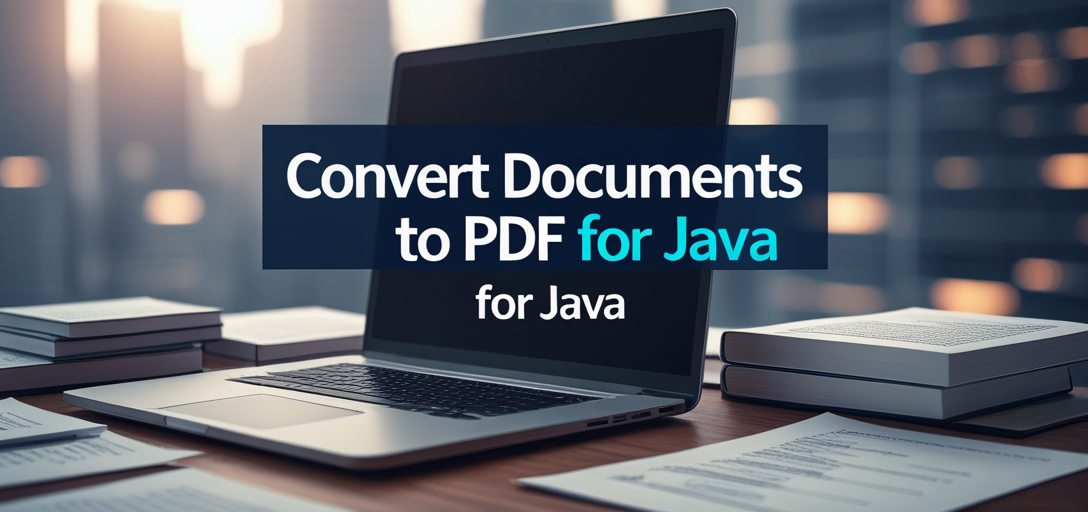Convert Documents to PDF in Java with GroupDocs.Viewer
Introduction
Struggling to convert documents into professional-quality PDFs using Java? GroupDocs.Viewer for Java is a powerful library designed to render various document types like DOCX, XLSX, PPTX, and more into PDFs efficiently. This guide will help you enhance your application’s document handling capabilities or provide a robust solution for enterprise-level document management.

What You’ll Learn:
- Set up GroupDocs.Viewer for Java using Maven.
- Render documents to PDF with simple code snippets.
- Manage output directories effectively.
- Practical applications of document rendering in real-world scenarios.
Let’s dive into the prerequisites!
Prerequisites
Ensure you have the following before implementing GroupDocs.Viewer for Java:
Required Libraries and Dependencies
- GroupDocs.Viewer: Version 25.2 or later.
- Maven for dependency management.
Environment Setup Requirements
- A working Java Development Kit (JDK) environment.
- Basic understanding of Java programming concepts.
Knowledge Prerequisites
- Familiarity with handling files in Java.
- Experience using Maven for project dependencies.
Setting Up GroupDocs.Viewer for Java
To get started, include GroupDocs.Viewer as a dependency in your Maven project:
Maven Configuration
Add the following to your pom.xml file:
<repositories>
<repository>
<id>repository.groupdocs.com</id>
<name>GroupDocs Repository</name>
<url>https://releases.groupdocs.com/viewer/java/</url>
</repository>
</repositories>
<dependencies>
<dependency>
<groupId>com.groupdocs</groupId>
<artifactId>groupdocs-viewer</artifactId>
<version>25.2</version>
</dependency>
</dependencies>
License Acquisition
GroupDocs offers various licensing options:
- Free Trial: Download and test with limited features.
- Temporary License: Obtain full-feature access during evaluation.
- Purchase: Acquire a paid license for long-term use.
To initialize GroupDocs.Viewer, import it into your Java project using Maven’s dependency management system.
Implementation Guide
We’ll break down the implementation into key features: rendering documents to PDF and managing output directories.
Rendering a Document to PDF
GroupDocs.Viewer for Java makes it easy to convert documents into PDF format, ensuring portability and security across platforms.
Step 1: Define Output Path
First, specify where the rendered PDF will be saved:
String outputFilePath = "YOUR_OUTPUT_DIRECTORY/output.pdf";
PdfViewOptions viewOptions = new PdfViewOptions(outputFilePath);
Step 2: Initialize Viewer and Render Document
Create a Viewer instance with your document path to render it into a PDF file.
try (Viewer viewer = new Viewer("YOUR_DOCUMENT_DIRECTORY/SAMPLE_DOCX")) {
viewer.view(viewOptions); // Renders the document using specified options
}
The rendered PDF will be saved at the specified output directory, ensuring easy access and management.
Utility for Managing Output Directory Path
Managing file paths is crucial in any application. Here’s a utility function that ensures your output directories are correctly set up:
import java.nio.file.Files;
import java.nio.file.Path;
import java.nio.file.Paths;
import java.io.IOException;
public static Path getOutputDirectoryPath(String folderName) {
Path outputDirectory = Paths.get("YOUR_OUTPUT_DIRECTORY", folderName);
try {
Files.createDirectories(outputDirectory); // Create directory if it doesn't exist
} catch (IOException e) {
e.printStackTrace(); // Handle I/O exceptions gracefully
}
return outputDirectory;
}
This function checks for the existence of a specified directory and creates it if necessary, streamlining file management.
Practical Applications
GroupDocs.Viewer’s PDF rendering capabilities can be applied in various real-world scenarios:
- Document Archiving: Convert legacy documents to PDF for long-term storage.
- Web Publishing: Prepare reports or presentations for online viewing.
- Secure Document Sharing: Render sensitive information into secure PDFs before distribution.
- System Integration: Integrate with CRM systems to automate document generation and sharing.
- Batch Processing: Use in applications that require converting large volumes of documents.
Performance Considerations
When working with GroupDocs.Viewer, consider the following for optimal performance:
- Memory Management: Ensure your application efficiently manages Java memory, especially when handling large documents.
- Resource Optimization: Optimize resource usage by fine-tuning rendering options and managing file streams properly.
- Batch Processing: When processing multiple files, manage threads and resources to prevent bottlenecks.
Conclusion
In this tutorial, we explored how to use GroupDocs.Viewer for Java to render documents into PDFs. By following the steps outlined, you can integrate powerful document conversion capabilities into your applications, enhancing both functionality and user experience.
Next Steps:
- Experiment with different document formats.
- Explore additional features of GroupDocs.Viewer, such as watermarking or annotations.
- Integrate this solution into a larger Java application to see its full potential.
Ready to transform your documents? Dive in and start coding!
FAQ Section
Q: How can I troubleshoot rendering issues with GroupDocs.Viewer? A: Ensure all dependencies are correctly included. Check for exceptions in your code logs and consult the documentation for specific error codes.
Q: Can I render password-protected documents to PDF using GroupDocs.Viewer? A: Yes, but you’ll need to provide the necessary decryption information as part of your rendering options.
Q: What formats does GroupDocs.Viewer support for conversion to PDF? A: It supports a wide range, including DOCX, XLSX, PPTX, and many more. Check the API documentation for an exhaustive list.
Q: How can I optimize performance when converting large documents? A: Utilize efficient memory management techniques and consider processing documents in batches.
Q: Is GroupDocs.Viewer suitable for enterprise applications? A: Absolutely! It’s designed to handle extensive document conversion needs, making it ideal for enterprise solutions.
Resources
- Documentation: GroupDocs Viewer Java Documentation
- API Reference: GroupDocs API Reference
- Download: GroupDocs Downloads
- Purchase: Buy GroupDocs License
- Free Trial: Try GroupDocs for Free
- Temporary License: Get a Temporary License
- Support: GroupDocs Forum
Embark on your journey with GroupDocs.Viewer for Java and elevate your application’s document handling capabilities today!